2169
Views & Citations1169
Likes & Shares
Jel code: C01, C22, C23, C32, C33, J64, O18, P25, R23.
REVIEW OF LITERATURE
In the process of economic growth, most of the time it is found that economic growth is higher than employment growth because a good part of economic growth is derived from an increase in productivity and only a part from using more labor. In India, unemployment attributed negative development of economic activities (Chand, Tiwari & Phuyal, 2017). But according to Padder & Mathavan, (2021) there is no such inverse relationship between economic growth and unemployment in India.
The liberalization and privatization process of the 1990s has brought about accelerated growth in India’s GDP, but in case of the growth of employment it has decelerated which is described as “jobless growth” (Padder, 2018). According to Bhattacharya & Sakthivel, (2007) estimates although there has been a mild acceleration in the output growth rate in the post-reform period, there has been a sharp decrease in the employment growth rate during the same years in India and its constituent states. (Ghose (2015). has studied that improvement of employment condition in India requires transfer of labor from the unorganized sector to the organized sector, which can only be possible when the rate of growth of organized sector employment exceeds that of the labor force in the economy and laborers are trying to develop themselves in skill-based education.
The patterns of urbanization are very diverse among the states. Delhi, Goa & Mizoram have recorded the significant level of urbanization. In India urbanization has increased faster than expected during 2001-2011 (Bhagat, 2001). Though the urbanization rate is increasing but urbanization mainly occurred due to migration from rural to urban areas, so unemployment in urban areas are increasing. Giri, (1998) found that during 1970-80 there was faster population growth in the small & medium urban centers as because of the location shift of various secondary and tertiary sectors. As rapid population growth could not be absorbed by agricultural sector so there was an increase in workforce participation in low income urban activity. Kundu & Mohanan, (2009) observed that workers population ratio had increased in recent years particularly for women. Unemployment had increased sharply under daily status as because of mismatch between growth in employment and labor supply, as the poor household send larger number of family members to survive. Prakash & Abraham, (2008) explain the trends in unemployment which indicate lower unemployment rate during post-reform period as compared to pre-reform period. Chowdhury, (2011) concentrated on the NSS data of 2009-10 and observed that there was a stagnant condition in Indian employment. There was a decrease in unemployment, but not because of an increase in employment rather a decrease in the number of people participation in the work. Levine, (2011) in his paper has opined that in India with the help of economic growth unemployment problem can be removed or new employment can be generated. In fact, during post reform period jobless growth has become menacing problem for which inclusive growth strategy has been taken in 11th five-year plan to overcome this bad situation (Parvathamma, 2014). Prakash & Abraham, (2008) explain the trends in unemployment which indicate lower unemployment rate during post-reform period as compared to pre-reform period. Nair, (2020) has recommended that, to reduce unemployment adequate skill based and vocational training is required, also increasing Govt. investment is needed.
Objective of the Study Data Collection and Variables
This study employs annual time series data over the period of 1991-2019 for India. We get the annual time series data about Unemployment and GDP during 1991-2019 from ILO. From the Census of India, we can get the Urbanization and Migration data for three distinct decades. The first objective of this paper is to investigate the relationship between economic growth and unemployment during post-reform period using time-series data. The second objective is to find out the relationship between urbanization and unemployment. The third objective is to estimate the effect of unemployment on migration during 1991-2011.
ESTIMATES
Relationship between Economic growth and Unemployment during 1991-2011: Long-run analysis
Unemployment is one of the most important socio-economic features for any country. So, economic growth of any country depends on the employment as well as unemployment situation of any country. First this paper will estimate the long-term relationship between unemployment and GDP for the post reform period. The cointegration between them can be checked by the using Engle- Granger method. The steps are:
Transforming the GDP and Unemployment data in logs we examine their stationarity by applying the ADF test. From Table 1 we can say that both lgGDP and lgUnemployment is non-stationary in level but stationary in first-difference, i.e. lgGDP-I(1) and lgUnemployment-I(1).
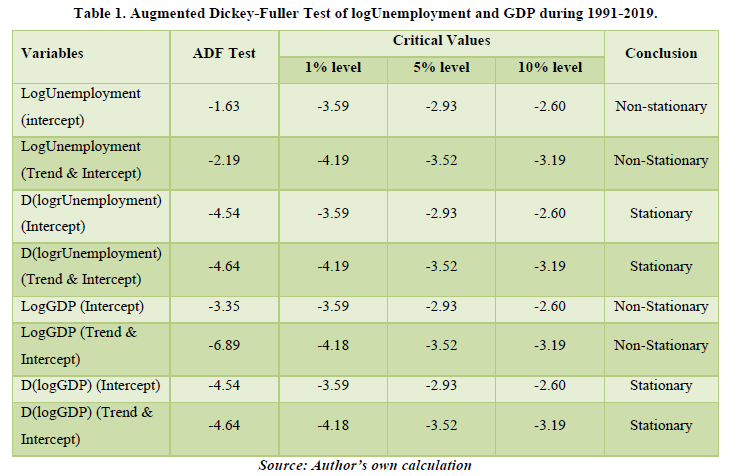
Since both the variables are I(1), we run a simple OLS regression of lgUnemployment on lgGDP using the ordinary least square method.
The estimated regression equation is:
(1)
So, from this regression equation, we get the result that Gross Domestic Product have a negative relationship with Unemployment. From the relationship we get the idea that, 1% increase in unemployment will decrease GDP by 3.667%. So, with the increase in unemployment the GDP rate decreases, i.e. if the unemployment rate increases then economic growth will decrease. In the equation 1, both GDP and Unemployment variables are in logs, the estimated slope coefficient (-3.667) represents long-run elasticity of GDP to change in unemployment.
Now, we will generate the residual series i.e. the error term series for each year to estimate the cointegration test. Using ADF test, we will check the residual series is stationary or not. Using this test, we come to know that the residual series is stationary in level (the null hypothesis of a unit root is rejected). This implies that the cointegration between GDP and Unemployment is valid.
As there is cointegration between GDP and Unemployment, we estimate the error correction model. This ECM can be summarized as:
(2)
These results are quite satisfactory especially because the coefficient of the residual is negative and statistically significant, which implies that if there were any short-term disturbances from the long-run stable relationship, such a disturbance would be corrected over time and the long-run stable relationship would be resorted. Here, -2.74 gives short-run elasticity of GDP with respect to change in Unemployment. This is expectedly lower than the long-run elasticity.
JOHANSEN APPROACH
Cointegration, an econometric property of time series variable, is a precondition for the existence of a long run or equilibrium relationship between two or more variables having unit roots (i.e. Integrated of order one). The Johansen approach can determine the number of co-integrated vectors for any given number of non-stationary variables of the same order (Ray, Pal & Ray, 2011).
Also, from Johansen test of co-integration we can determine the long run relationship between the GDP and Unemployment during 1991-2019.
To check the cointegration relationship between GDP and Unemployment, it is necessary to find optimal log length. Using LR, FPE, AIC and HQ we can determine the optimal lag length, which reveal that the optimal lag length is 2 (Table 2).
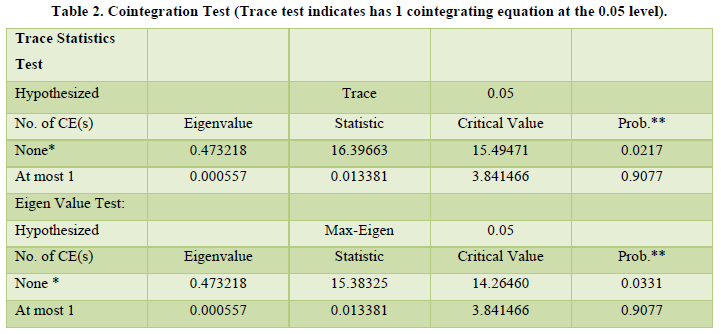
Max-eigenvalue test indicates 1 cointegrating eqn(s) at the 0.05 level.
So, from these two statistics we get the idea that, from both trace statistics and Maximum Eigen Value test we get that there is long run relationship between GDP and Unemployment i.e. there are some cointegration between them.
ERROR CORRECTION MECHANISM
In order to check the stability of the model we have estimated the vector error correction (VECM) model. The results of VECM model are presented in Table 3. The results indicate that the error correction term for GDP growth bears the correct sign i.e. it is negative and statistically significant at 5 percent significant level. It indicates 23 percent speed of convergence towards equilibrium position in case of any disequilibrium situation.

The results were checked for stability using the variance decomposition approach. This technique is used to compare the contribution extent of various time series. From variance decomposition approach, we get the idea that in 10 years periods 64.39% portion of GDP is contributed by own innovative shocks (Table 4). On the other hand, 35.61% deviation in GDP occurs due to unemployment reason.
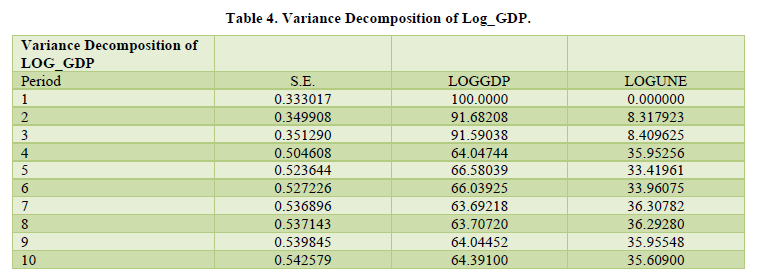
Granger causality test estimates whether the lagged variable of a variable can be introduced into other variable equations, to determine how the lagged variable can explain other variables. Table 5 suggest that, Unemployment granger causes economic growth i.e. GDP during 1991-2019, but GDP does not granger cause Unemployment.

Trend of Urbanization in India During 1991-2011: An Inter-State Analysis
In this section we are to examine the urbanization rate among the states in India during 1991-2011. The urbanization rate of any economy like India is the ratio between the urban population and the total population of the economy. Our estimates Table 6 reveal that irrespective of sex the urbanization rate has varied in India and its constituent states during the period under study. At the all-India level, it has increased from 25.43% in 1991 to 27.82% in 2001 and to 31.14% in 2011. It has increased in all the states excepting Bihar during 1991-2011. In 1991, irrespective of sex among the bigger states Maharashtra has shown the highest position in terms of urbanization rate, whose position has lost by Tamil Nadu both in 2001 and 2011. Among the smaller states, Goa has taken the highest position for the three census years. Six bigger states namely Gujarat, Karnataka, Kerala, Maharashtra, Punjab, Tamil Nadu, West Bengal and two smaller states namely Goa & Mizoram have shown the higher urbanization rate than the national level for the three census years irrespective of sex. All the union territories have the higher urbanization rate than the national level during 2001 - 2011. During 1991-2011, three major states namely Haryana, Kerala, Tamil Nadu and three smaller states namely Goa, Nagaland, Sikkim have shown an increase in rank. Among them, Kerala has shown the highest increase in rank with an increase in urbanization rate from 26% to 48%. Tripura is the only state which has shown the equality in ranking of urbanization during 1991-2011. It is observed that the smaller states and the union territories have recorded a significant urbanization level with Delhi topping the list where 93% are the urban population. The union territories have taken the first five ranking in urbanization rate in the three decades except in 2001and Goa has taken the fourth position. Among the bigger states, Assam and Bihar have respectively achieved the lowest urbanization rate in 1991and in 2011. Among all states and union territories, Dadra & Nagar Haveli is the least urbanized union territory in 1991, but Himachal Pradesh has occupied the same position with only 10% level of urbanization in the last two decades. During 1991-2011, only few.
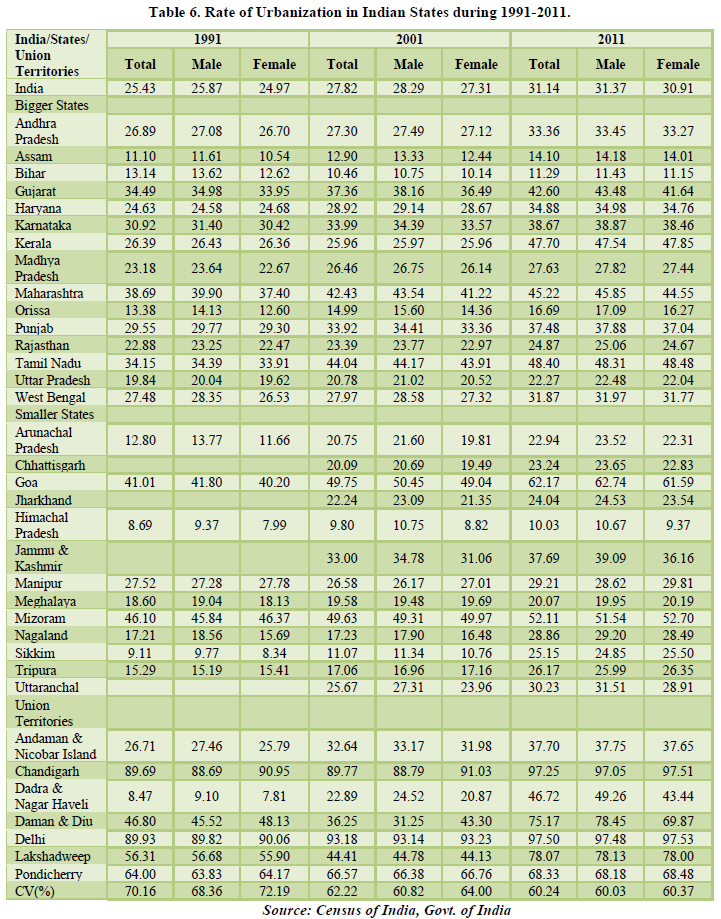
States have shown the higher female urbanization rate than the male one. The rate of male urbanization rate as well as the total urbanization rate has increased but the female rate has decreased during 1991-2001 in the states of Gujarat and Himachal Pradesh. During 1991-2001, Nagaland is the only state where the total urbanization rate has increased only due to increase in female rate. During 2001-2011, Himachal Pradesh has shown an increase in total urbanization rate but its male urbanization rate has shown a slightly decreasing rate. In 1991, the female urbanization rate is greater than the male one in the states of Haryana, Manipur, Mizoram, Tripura, Chandigarh, Daman & Diu, Delhi and Pondicherry. In 2001, no bigger states have the higher female urbanization rate than the male one whereas in 2011, Kerala and Tamil Nadu have the higher female urbanization rate than the male one.
Thus, we observe that the rate of urbanization has shown a rising tendency in the states and union territories of India during 1991-2011. Among the states the variation in urbanization rate for female has decreased more than the male one during this period. In 2011 the variation among the states in urbanization rate is more or less same for male and female.
Trend in Urban Unemployment during 1993-2010
During 1993-2010, the urban unemployment in India has decreased from 7.4% to 5.8%, though at first the rate of unemployment has increased slightly from 7.4% to 7.7%. In 1993, among the major states, the urban unemployment was highest for the state Kerala followed by Goa and West Bengal (Table 7). In this period, the states, namely Andhra Pradesh, Assam, Bihar, Kerala, Orissa, Tamil Nadu, West Bengal, Goa, Jammu Kashmir and Tripura whose unemployment were higher than the urban unemployment of India. Among all the states, the unemployment is lowest for the state Mizoram in 1993. In 2004-05, among all the states Goa had taken the highest position in urban unemployment followed by Kerala and Assam. Among all the states Arunachal Pradesh had lowest unemployment rate in India. In this time period, for the states, Assam, Bihar, Kerala, Maharashtra, Orissa, Tamil Nadu, West Bengal, Goa, Himachal Pradesh and Nagaland whose unemployment rate were higher than the Indian urban unemployment rate. In 2009-10, the unemployment rate is highest for the state Tripura followed by Kerala and Nagaland. The rate is lowest for the state Sikkim. In this period, some states namely, Bihar, Kerala, Orissa, Punjab, Tamil Nadu, West Bengal, Jharkhand, Himachal Pradesh, Jammu & Kashmir, Nagaland, Tripura and Uttaranchal have higher unemployment rate than the Indian unemployment rate. Almost all the union territories except Dadra & Nagar Haveli, Daman & Diu and Delhi had lower unemployment rate during 1993-2005 and for the next period Chandigarh, Daman & Diu and Delhi had lower unemployment rate than Indian Unemployment rate.
During 1993 to 2005, the unemployment rate has decreased for the following states namely Andhra Pradesh, Gujarat, Haryana, Karnataka, Orissa, Tamil Nadu, West Bengal and Tripura and for the following union territories Andaman & Nicobar Island, Chandigarh, Daman & Diu, Lakshadweep and Pondicherry. For the next period, most of the states had shown decreased except Punjab, Arunachal Pradesh, Jammu & Kashmir, Meghalaya, Nagaland and Tripura. Among the union territories, some union territories had shown a decrease in urban unemployment, namely Andaman & Nicobar Island, Chandigarh, Daman & Diu, Lakshadweep and Pondicherry during 1993-2010.
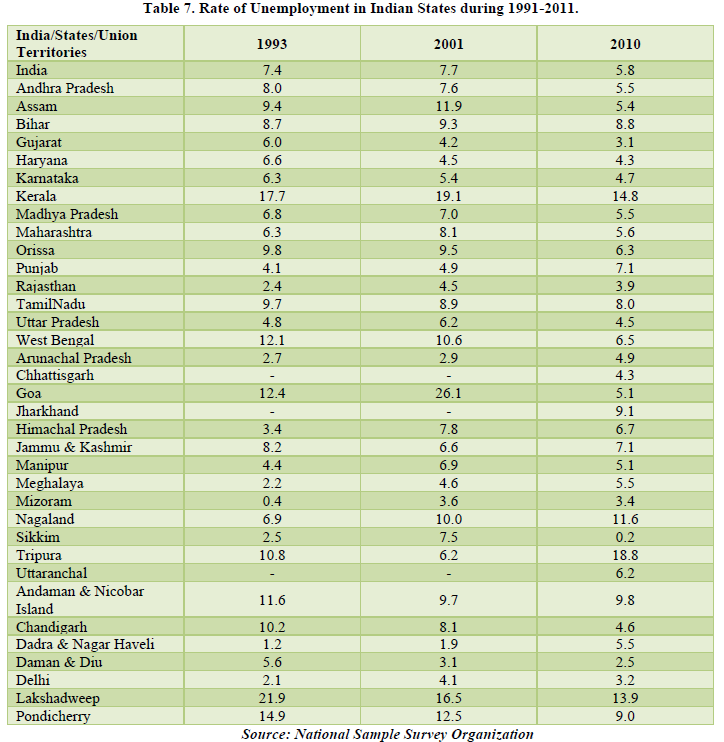
Relationship between the Urbanization and Unemployment during 1991-2011: Panel data Analysis
Panel data, also called cross-sectional time series data, are repeated observations on the same set of cross-section units. Two types of information are represented in cross-sectional time-series data: the cross-sectional information, reflected in the differences between subjects, and the time-series or within-subject information, reflected in the changes within subjects over time. Panel data regression techniques allow researchers to take advantage of these different types of information. A panel dataset should have data on n cases, over t time periods, for a total of n × t observations.
Fixed and Random Effects Models:
Consider the following model:
Also consider that the error term has the following structure:
Where it is assumed that ηit is uncorrelated with Xit. The first term of the decomposition, αi, is called an individual-specific effect; and the second part, ηit, corresponds to the common stochastic error term. In this formulation, the first part, αi, varies across individuals or the cross-section unit but is constant across time; this part may or may not be correlated with explanatory variables. The second part, ηit, varies arbitrarily across time and states.
The crucial assumption that distinguishes the fixed effects model from the random effects model is whether αi may or may not be correlated with the set of explanatory variables, Xit:
Random effects model: αi is uncorrelated with Xit.
Fixed effects model: αi is correlated with Xit.
Random Effects
The random effects model has the following structure:
The main assumption that differentiates this model from the fixed effects model is that the time-invariant country-specific effect αi is uncorrelated with Xit.
Fixed Effects
In contrast to the random effects case, the crucial assumption in the fixed effects model is that cov(Xit ,α i) ≠ 0. The model must therefore be estimated conditionally on the presence of the fixed effects.
Where the αi are unknown parameters to be estimated. However, consistent estimates of these additional parameters cannot be obtained (Cancado,2005). The Hausman test is used to test either RE estimators or FE estimators are consistent. If αi is uncorrelated with the explanatory variables, in this case, RE estimators are more efficient than FE estimators. If ai unobserved heterogeneity is correlated with the independent variables in the case, RE estimators are biased, while FE estimators are consistent. The hypothesis is formulated the following way under Hausman test as:
H0: Corr (ai, xj) = 0 RE estimators are more efficient than FE estimators.
H1: Corr (ai, xj) ≠ 0 FE estimators are more efficient than RE estimators.
To decide between fixed effect model or random effects model, we run simple Hausman test where the null hypothesis is that the random effect model is more efficient vs. the alternative hypothesis the fixed effect model is more efficient.
Choosing between Fixed Effects, Random Effects and Hausman Test:
The generally accepted way of choosing between fixed and random effects is running a Hausman (1978) test. The Hausman estimator is consistent and efficient, being usually the best choice when compared to both fixed and random effects estimators (Bhaumik, 2015).
Here our objective is to examine the relationship between urbanization and unemployment by using Census of India and NSSO for three census years. Using panel data analysis, the relationship between Urbanization and Unemployment in India has been checked during 1991-2011. The relationship can be written as,
From equation, it is found that there is an inverse relationship between urbanization and unemployment. Further the estimated coefficients of both the variables are statistically significant at 5% level. Thus, we can say that as the percentage of unemployment increases the urbanization in India falls.
Hausman Test
The selection between Fixed Effect Model and Random Effect Model is performed more rigorously by applying the Hausman test (Table 8).

If computed value of Chi-square is greater than the tabulated value, then we will reject that REM is consistent. Chi-square value is less than the tabulated value i.e. Random Effect Model gets accepted on the basis of Hausman test as the computed Chi-square value is statistically insignificant. Thus, we will choose Random effect model for this panel data. The Hausman test implies (correctly) the use of the random effects model formulations. The result shows the value of chi-square is 0.3134 which indicates that we accept the null hypothesis that the random effect model is more consistent and reject the alternative hypothesis that the fixed-effects model is consistent and efficient.
Relationship between Migration and Unemployment
Migration, as a component of growth of urbanization determined by many factors like poor living conditions, low agricultural productivity, poor medical care and unemployment, Employment opportunity, higher income, education, urban facilities etc.(lee,) among them unemployment is one of the important push factors. So due to unemployment in rural area, migration towards urban area from rural area should increase. Intra-state In-migrants are those who are coming from rural areas to urban areas in search of employment i.e. many people leave the rural areas in search of employment due to unemployment problem in rural areas. This study is trying to measure the relationship between the intra-state in-migrants and due to unavailability of time-series data about migration we cannot use the cointegration test between migration and unemployment. Due to urban unemployment people migrated from rural are to urban area. To estimate the relationship between the inter-state in-migrants and rural-unemployment can be determined using panel data analysis:
Also, the relationship between out-migrants and rural-unemployment can be described as:
Here, from this estimate we came to know that, with the increase in Rural_Unemployment, the flow of migrants from rural area to urban area increases, and this is statistically significant. So, the unemployment is one of the main determinants of rural-urban migration.
Correlated Random Effects - Hausman Test (Table 9)
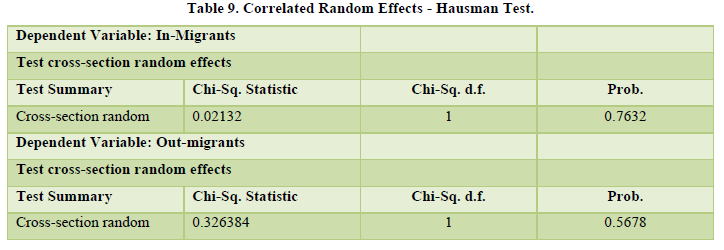
In the previous analysis we had discussed earlier that if computed value of Chi-square is greater than the tabulated value, then we will reject that REM is consistent. Chi-square value is less than the tabulated value i.e. Random Effect Model gets accepted on the basis of Hausman test as the computed Chi-square value is statistically insignificant. Thus, we will choose Random effect model for this panel data. The Hausman test implies (correctly) the use of the random effects model formulations. The result shows the value of chi-square for in-migrants and out-migrants are 0.02132 and 0.3264, which indicate that we accept the null hypothesis that the random effect model is more consistent and reject the alternative hypothesis that the fixed-effects model is consistent and efficient.
CONCLUSION
Unemployment has a long-term effect on economic growth and urbanization during the post reform period. Due to urbanization rural people migrated towards urban areas in search of employment. Though urban employment has increased but it can’t cover up all unemployment of urban areas so the rate of unemployment in urban areas can’t be reduced.
Policy makers should concentrate on employment generation programmes in urban as well as rural areas; so that unemployment can be reduced and economic growth can be attained. Also, urbanization is negatively related with unemployment. So, by reducing the unemployment problem the urbanization can be achieved as well as economic growth can be attained.
- Bhattacharya B.B. & Sakthivel S. (2007) Economic Reforms and Jobless Growth in India.
- Bhagat. R.B. & Mohanty. S. (2009). Emerging Pattern of Urbanization and the Contribution of Migration in Urban Growth in India. Asian Population Studies 5, 5-20.
- Bhati, R.K. (2015). A Study of Rural to Urban Migration in India presented at ASM’s International E-Journal Ongoing Research in Management and IT. Available online at: https://www.researchgate.net/piblication/331088765
- Bhaumik, S.K. (2015). Principles of Econometrics A Modern Approach Using EViews Oxford University Press.
- Ge X, Zhou Z, Zhou Y, Ye X, Liu S. (2018). A Spatial Panel Data Analysis of Economic Growth Urbanization, and NOx Emissions in China. Int J Environ Res Public Health, 15, 725.
- Ghose. A. (2014). India Needs Rapid Manufacturing LED Growth. Available online at: http://www.ihdindia.org/Working%20Ppaers/2015/WP-0115.pdf
- Keyfitz, N & Philipov, D (1981). Migration and Natural Increase in the Growth of Cities Geographical Analysis. Available online at: www.researchgate.net.in
- Kundu, A (2003). Urbanization and Urban Governance Search for Perspective beyond Neo-Liberalization. EPW, 38, 3079-3087.
- Exclusionary Urbanization in Asia a Macro Overview (2009). EPW, 44, 48-58
- Kumar, D. & Sinha, R (2018). Migration and India’s Urban Transformation Consequences and Challenges. The Indian Economic Journal, 18, 172-189
- Levine, L. (2013). Economic Growth and the Unemployment Rate, Congressional Research Service Report for Congress. Available online at: www.crs.gov
- Mathur, V. K. & Stein, S.H. (1993). The Role of Amenities in a General Equilibrium Model of Regional Migration and Growth. Sothern Economic Journal, l59, 394-409.
- Nair, S (2020). A Study on the Causes and Impact of Unemployment of India. International Review of Business Economics.
- Padder, A.H. & Mathavan, B (2021). The Relationship between Unemployment and Economic Growth in India Granger Causality Approach. Not. Volatiles & Essent. Oils, 8, 1265-1271.
- Prakash B. A & Abraham M.P. (2008). Trends and Characteristics of Unemployment in India in B. A. Prakash(eds.), The Indian Economy Economic Reforms & Performance, Pearson Education.
- Parvathamma G. L. (2014). An Assessment on Status of Employment During Pre And Post Reforms Era in India. BEST International Journal of Humanities, Arts, Medicine and Sciences (BEST IJHAMS), 2, 87-94.
- Reddy D. Narasimha (2012). Globalization, Labor and Employment in India. Available online at: http://works.bepress.com/narasimha_reddy/8
- Roy S., Pal M.K. & Ray. I.A. (2012). Assessing Causal relationship between Education and Economic Growth in India. Vidyasagar University Journal of Economics, 16, 41-61
- Sivaramakrishnan K.C., Kundu. A & Singh. B.N. (2007). Handbook of Urbanization in India. Singapore Oxford University Press.
- Zhao Y. & Wang S. (2015), “The Relationship between Urbanization, Economic Growth and Energy Consumption in China: An Econometric Perspective Analysis. Sustainability. Available online at: www.mdpi.com/journal/sustainability

